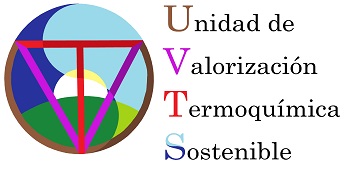1. Combustion and gasification
2. Cleaning and treatment of effluents from thermochemical conversion processes
This research line addresses the development and assessment of advanced technologies - physical, chemical and catalytic- for the treatment of effluent streams from thermochemical conversion of coal, biomass and wastes. Thus, gases need to be subjected to clean-up stages due to environmental requirements or equipment tolerance and to conditioning, upgrading and composition adjustment when using syngas as raw material for production of chemicals and biofuels. CIEMAT focuses on the development of advanced systems to meet those needs.
Activities in this research line encompass experimental studies at laboratory and pilot scale.
Within this research line, CIEMAT is working on the following sub-lines:
2.1 Clean-up and processing
This scientific sub-line is dealing with the study and development of materials, systems and processes for removal of pollutants and harmful compounds generated in thermochemical processes (SOx, NOx, tar, H2S, NH3, HCl, etc.) as well as for upgrading and composition adjustment to meet the requirements imposed by subsequent process units (e.g. fuel cells, biofuels production, chemical synthesis, etc.).
Examples of activities included in this sub-line are:
- Pollutants removal and abatement (e.g. H2S, Tar, SOx, NOx, etc.),
- Gasification gas conditioning and upgrading (e.g. cracking, reforming, water-gas-shift, etc.),
- Upgrading of products quality from thermochemical conversion of coal, biomass and waste, e.g. fractions from liquefaction and pyrolysis
Activities in this research sub-line encompass experimental studies at laboratory and pilot scale.
2.2 Hydrogen production
It is geared towards the selective separation of hydrogen from H2-containing streams, such as gasification, reforming, pyrolysis, for its use as fuel (fuel cells, turbines) or as feedstock for chemical processes.
The research and development activities focus on warm-high temperature systems based on membranes (palladium and binary, ternary alloys) and integrated hybrid reactor systems comprising membrane + catalyst, sorbent + catalyst, bifunctional materials, sorbent + membrane, sorbent + catalyst + membrane in processes related to the thermochemical field such as reforming, water-gas-shift, sorption-enhanced, etc. The integrated system concept coupled with selective separation of hydrogen is also applicable to other fields of chemical engineering.
Activities in this research sub-line encompass experimental studies at laboratory and pilot scale.
2.3 Capture and Valorisation of CO2
It is addressed to the search and developments of technologies for utilization of CO2 to allow the sustainable use of coal for power generation as well as to minimize the release of CO2 form thermochemical conversion of biomass and waste and from other industrial sources.
CO2 capture activities include the study and development of sorption materials, systems and processes, both in pre-and post-combustion, as well as by means of systems based on electrochemical promotion of catalysis.
As for the use of CO2 as raw material the aim is its conversion into fuels (e.g. methane) and/or chemical products (e.g. alcohols, hydrocarbons). Activities include both the study and development of materials, systems and processes based on conventional sorption and heterogeneous catalysis and catalytic technologies assisted by electrochemical promotion and membrane reactor integrated systems.
Activities in this research sub-line encompass experimental studies at laboratory and pilot scale.
